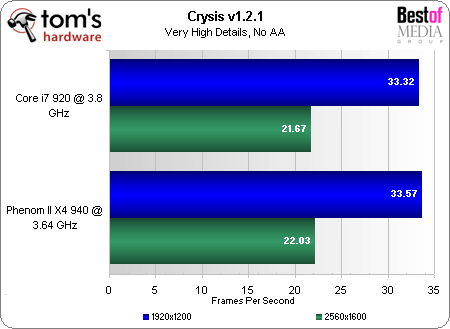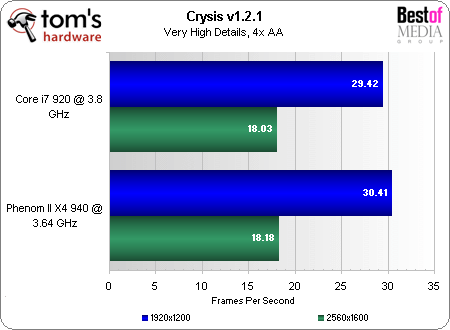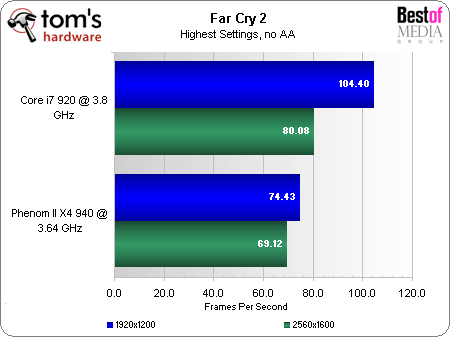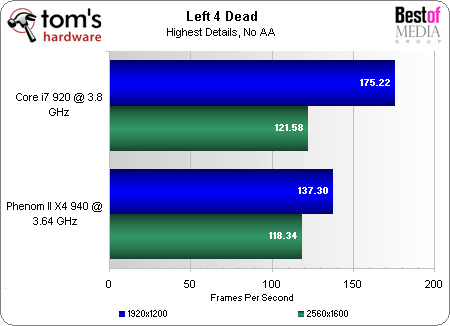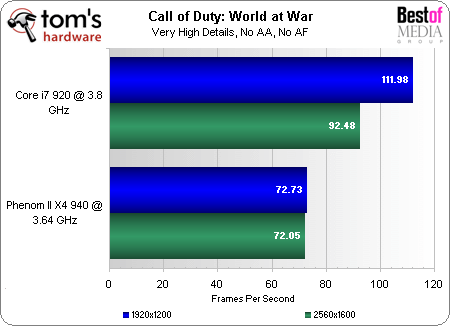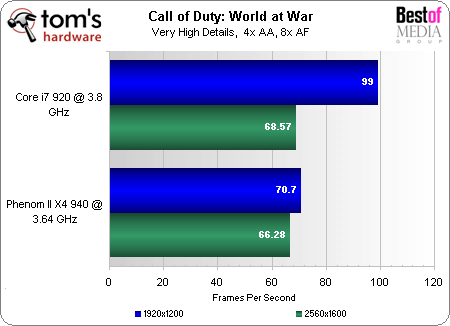Overclocking: Core i7 Vs. Phenom II
Benchmark Results: Gaming
It’s no secret that a pair of AMD RV770 GPUs need a beefy CPU in order to reach their potential. As we see in both charts, however, the overclocked Core i7 and Phenom II processors are both able to serve up enough horsepower to reach the 4870 X2’s potential. In order to get any higher frame rates here, we’d need more graphics muscle.
Both the i7 and Phenom II are able to serve up playable frame rates at either 1920x1200 or 2560x1600 with no antialiasing (AA) enabled. You can see the Phenom II stretching its legs as far as they’ll go, in fact, as the shift to a higher resolution costs hardly any performance. Turning on the visual details taxes the graphics card harder at 1920x200, and there’s as large of a performance gap. There isn’t a huge difference at 2560x1600, either. But because both configurations drop below 60 frames per second (FPS), the fact that Intel’s Core i7 stays 10 FPS ahead remains significant.
With no AA or anisotropic filtering (AF), the Intel platform exerts its strength at 1920x1200. At 2560x1600, though, graphics horsepower is what limits the speed of these setups, as they score similarly. The same situation materializes when we turn on AA and AF—it doesn’t matter which configuration you buy as performance is equal.
Whereas Left 4 Dead taxed graphics horsepower heavily, Call of Duty seems fairly demanding for CPUs. Without the AA and AF, AMD’s Phenom bottlenecks just over 70 FPS, while the Intel setup peaks at 111. Even with greater graphics demands, the bottleneck seems to be at the same spot with AA and AF turned on, as it’s only at 1920x1200 on the i7 platform that we see anything higher than 70 FPS.
Get Tom's Hardware's best news and in-depth reviews, straight to your inbox.
Current page: Benchmark Results: Gaming
Prev Page Benchmark Results: Productivity Next Page Power Consumption-
Roffey123 At last a P2/i7 comparison to shut the people whining for one up. In all I think its a fair comparison - although I am disappointed that AMD's OC potential wasn't as good as they made it out to be. But as all overclockers know - not all chips are the same or have the same OC potential.Reply
The 3DS Max benchmark was puzzling as well, considering that i7 has 8 threads at its disposal. Do you guys have any idea as to why the AMD beat the i7 in that test; despite having only half as many threads? -
unclefester I thought it funny they use an ATI card on the Intel board (not that it makes a difference).Reply
Would have liked to see what the PII can gain or not gain by using the FSB not just the multiplier.
Didn't see anything about memory timings either. As most PII OC's have been done at @880MHz.
Overall a decent review.
So Ford vs Chevy goes on. -
apache_lives I would love to see a high end overclocked Core 2 Quad 9 series in the tests here to see a price comparison - cheaper and already established platform etc.Reply
Also note that i7 platform should also feel more alive and responsive (un-benchmarkable) thanks to high memory bandwidths and more threads to balance things out like the P4C's and CL2 Dual Channel DDR1 - reguardless if it performed lower then the AMD A64's at the time it felt more responsive!
Intel also has that more solid platform to back that CPU and options for Crossfire AND SLi so its more the premium option, but that cheaper AMD setup is too close to the i7 for my liking - a few shifts in prices and models should show an interesting result in the new few weeks.
AM3 should be interesting, higher headroom + lower power etc (like 939 to AM2). -
cangelini Uncle,Reply
With the Black Edition, that's really the value there. You want to use the multiplier for a clean, easy overclock. Once you've found your ceiling, use the reference clock to fine-tune the setup. -
vekere I hear AMD is going to hire Sylar to look at the new Core i7 processor so this year we will have an answer.Reply -
kschoche The WINRAR tests are so close to exactly half the time on the Intel chip compared to the AMD chip that I'd love to see how the results show up if you turn off hyperthreading, not that its a particularly meaningful result, but would be cool to look at still.Reply -
jtnstnt I'm curious about the heatsink selection on the Phenom II. I looked up the Ajigo MF091 and it didn't look too impressive. While the Intel system gets the Thermalright 120mm True extreme. Whats up with that?Reply -
apache_lives jtnstntI'm curious about the heatsink selection on the Phenom II. I looked up the Ajigo MF091 and it didn't look too impressive. While the Intel system gets the Thermalright 120mm True extreme. Whats up with that?Reply
Heh very good point there, although it depends on wether the limits of the OC was architectural or thermal
